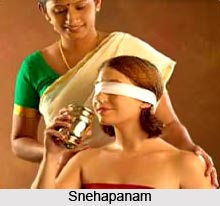 Snehapanam is an Ayurvedic treatment given to patients for the cure of gastroenterological ailments. Snehapanam is measured useful in curing different conditions like osteo-arthritis, certain skin diseases like psoriasis, chronic constipation and many other diseases. Snehapanam is also considered to be an effective treatment for peptic ulcer.
Snehapanam is an Ayurvedic treatment given to patients for the cure of gastroenterological ailments. Snehapanam is measured useful in curing different conditions like osteo-arthritis, certain skin diseases like psoriasis, chronic constipation and many other diseases. Snehapanam is also considered to be an effective treatment for peptic ulcer.
Character of Snehapanam
Snehapanam is categorized by the oral intake of ghee (purified buttermilk) made from cow`s milk for internal purification before starting the Panchakarma therapy (purva karma) or the treatment. The dose of Snehapanam Ayurvedic therapy increases gradually from day one until day 8 or day 14 according to prescription.
Procedure of Snehapanam
Overproduction of gastric juice in the digestive track is believed to be neutralized by the passage of the medicated ghee. The choice of medicines to be used in the ghee varies with patients. Generally the patient is given a dose of Snehapanam of specific quantity and quality, based on the ability of the person to digest the medication. The person is also not allowed to eat anything till the medicinal ghee digests completely in his or her digestive tract. Snehapanam therapy for peptic ulcer may end in less than eight days.
According to physician`s prescription Snehapanam can be practised fortnightly.
Usefulness of Snehapanam
Snehapanam is considered as the Ayurvedic treatment practised in the ancient times. Now in India and also in the whole world, the Ayurvedic hospitals use this mode of treatment as one of the most beneficiary to the chronic diseases. But, Snehapanam is helpful for patients who are suffering from different pain related diseases. In South Indian states like Kerala, Karnataka, Tamil Nadu and Andhra Pradesh the ayurvedic hospitals use this ancient technique of treatment to treat the patients who are suffering from the skin diseases like psoriasis. This mode of treatment is also helpful in skin allergy, rashes and the hair losses. It is also helpful for the osteo-arthritis type diseases and the certain primary diseases like constipation, plies and many other stomach related health problems. Snehapanam also acts as the superior and the helpful for the patients who are suffering from urinary disorders, diabetes mellitus, gout and epilepsy in moderate and superior manner.




















